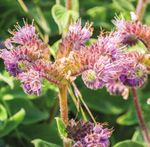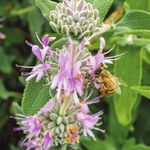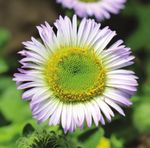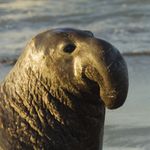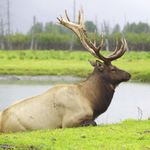EXPLORE OUR STATE PARKS! - California State Parks Foundation
←
→
Page content transcription
If your browser does not render page correctly, please read the page content below
CALIFORNIA WILDLIFE & NATIVE PLANT GUIDE EXPLORE OUR STATE PARKS! Be on the lookout for these wildlife species and native plants as you discover California’s parklands, knowing that you are protecting and preserving their natural habitat through your support! Always be respectful of animals and their habitats — and observe wild animals from a safe distance. www.calparks.org
NORTHERN CALIFORNIA WILDLIFE
AÑO NUEVO STATE PARK:
ELEPHANT SEALS
Marvel at northern elephant seals during a guided
tour inside the Año Nuevo Coast Natural Preserve.
Up to 10,000 elephant seals return to the shores
each winter to breed and give birth along the
scenic dunes and beaches. Don’t forget your
camera!
PORTOLA REDWOODS STATE PARK:
MARBLED MURRELETS
Look high into the redwoods and you may spot
one of these endangered seabirds. The murrelet
nests high in the redwood canopy, hundreds of
feet above ground. Old-growth trees in Portola
provide an important habitat for the marbled
murrelet.
HUMBOLDT LAGOONS STATE PARK:
ROOSEVELT ELK
Park your car and catch a glimpse of majestic
Roosevelt elk from afar. Once nearly extinct,
herds of Roosevelt elk can frequently be spotted
on the prairie or grazing south of Stone Lagoon.
If you visit in May and June, you may even see
newborn calves!
MOUNT DIABLO STATE PARK:
BLACK-TAILED DEER
A “keystone” species in the native California
coastal ecosystem, black-tailed deer bound
through the 20,000-acre park. If you visit during
the summer, these beauties will be reddish-
brown, and brownish-gray during the winter.NORTHERN CALIFORNIA PLANTS
DOUGLAS IRIS (Iris douglasiana)
Blue, pink, purple, white and yellow: this stunning
wildflower comes in an array of colors.
WHERE TO FIND IT: Grassy places, meadows,
coastal prairie and in the understory of evergreen
forest from Del Norte County to Santa Barbara
County
FLOWERING SEASON: Spring and winter
BLUFF LETTUCE (Dudleya farinosa)
This succulent is an important hummingbird plant
along the coast. The tips of its basal rosettes are
often bright red during the dry season.
WHERE TO FIND IT: Northern California on bluffs
and coastal hillsides
FLOWERING SEASON: Summer
ROCK PHACELIA (Phacelia californica)
The dense, “hairy” cluster of bell-shaped
flowers are a food source for the endangered
Mission Blue butterfly.
WHERE TO FIND IT: Coastal northern California in
chaparral, woodland, coastal bluffs and grassland
FLOWERING SEASON: Spring and summer
SEASIDE DAISY (Erigeron glaucus)
With its golden yellow face and flower clusters of
deep blue, purple, lavender or white, these
perennials brighten many state parks.
WHERE TO FIND IT: Coastal California on
beaches,coastal bluffs and dunes
FLOWERING SEASON: Spring, summer, and winterSOUTHERN CALIFORNIA WILDLIFE
SALTON SEA STATE RECREATION AREA:
BROWN AND WHITE PELICANS
Bring your binoculars! The Salton Sea is a bird
watcher’s delight. From brown and white pelicans
to herons, kingfishers and more, the Salton Sea
has long-provided sanctuary to a diverse
collection of wildlife and the critical habitats
that nurture them.
TORREY PINES STATE NATURAL
RESERVE: GRAY WHALES
You won’t forget the sight of a gray whale
migration. High above the sea, the bluffs are a
great spot to watch the graceful sea mammals.
Go late in the season to see females and their
calves migrate back north.
SILVERWOOD LAKE STATE RECREATION
AREA: BALD EAGLES
Winter is the perfect time to take a Bald Eagle
Barge Tour here, while bald eagles glide silently
above the lake, fishing for their next meal. This bird
of prey winters on the lake shores, and water-
oriented birds such as snowy egrets and loons
are plentiful.
CUYAMACA RANCHO STATE PARK:
PACIFIC TREE FROGS
You’ll know this small amphibian by its dark
“mask”— but you’ll have to look closely! Smaller
than a chicken egg, the Pacific tree frog also has
the ability to change its color based on the air
temperature to avoid being spotted by predators.SOUTHERN CALIFORNIA PLANTS
CALIFORNIA BUCKWHEAT
(Eriogonum fasciculatum)
If you see honey bees on this drought-resistant
bush, don’t be surprised! Its pink and white
flowers are a good source of nectar.
WHERE TO FIND IT: Southwestern California on
scrubby slopes, in chaparral and dry washes
FLOWERING SEASON: Spring, summer, and fall
PURPLE SAGE (Salvia leucophylla)
Calling all wildlife! This highly aromatic shrub
attracts a variety of birds and insects with its
purple flowers.
WHERE TO FIND IT: Southern coast of California
and Baja California, on dry, open hillsides
FLOWERING SEASON: Spring and summer
SUGAR SUMAC (Rhus ovata)
The flower clusters of this fire-resistant shrub
may look pink, but they actually have white to
pink petals with red sepals.
WHERE TO FIND IT: Southern California in chaparral
indry canyons and slopes
FLOWERING SEASON: Spring and winter
DESERT LAVENDER (Hyptis emoryi)
Bees and butterflies love this member of the mint
family. Its purple buds and small, furry leaves
make this drought-resistant plant easy to spot.
WHERE TO FIND IT: Southwestern California in
sandy or gravelly soils
FLOWERING SEASON: Spring and winterYou can also read





